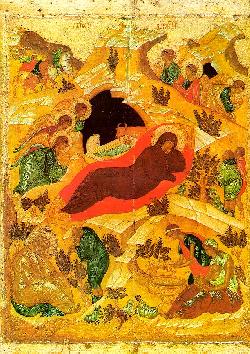
A Follower of Rublev(?), Moscow School, early 15th century.
From Zvenigorod. Tretyakov Gallery, Moscow, 71 x 53 cm.

 This icon is interesting for several reasons. Some scholars attribute it to Andrei Rublev or one of his close followers. That immediately makes us pay attention to the excellence of the icon's composition and to the depth of the message conveyed by the author. Moreover, while the figures and actions are depicted clearly (elements of monumentality) there is also complexity in the number of figures and diversity of actions. At the same time, this complexity is carefully controlled and does not detract from certain important, spiritual ideas represented in the icon. One of these ideas seems to be the miraculous power of God and the perfection -- the completion -- of His divine will on earth. The painter succeeded in showing this "simplicity through complexity" by making each auxiliary scene reflect a reaction to, a consequence of or an event connected with the birth of Jesus. In this way his birth acts as a unifying force in this icon, as it has been for many believers around the world; these considerations add to the icon's symbolic power.
This icon is interesting for several reasons. Some scholars attribute it to Andrei Rublev or one of his close followers. That immediately makes us pay attention to the excellence of the icon's composition and to the depth of the message conveyed by the author. Moreover, while the figures and actions are depicted clearly (elements of monumentality) there is also complexity in the number of figures and diversity of actions. At the same time, this complexity is carefully controlled and does not detract from certain important, spiritual ideas represented in the icon. One of these ideas seems to be the miraculous power of God and the perfection -- the completion -- of His divine will on earth. The painter succeeded in showing this "simplicity through complexity" by making each auxiliary scene reflect a reaction to, a consequence of or an event connected with the birth of Jesus. In this way his birth acts as a unifying force in this icon, as it has been for many believers around the world; these considerations add to the icon's symbolic power.
Another interesting facet of this icon is that although Mary is the largest figure, she does not seem to be its most important (though perhaps she is the most visually noticeable) feature. Though one's eyes may be drawn to her immediately, the entire composition of the icon reveals that it is what Mary represents – the power, mercy, and fulfillment of God's will – that is given the most emphasis, not the woman herself.
The colors are warm and, by their complimentary nature, contribute to the unity of the whole. Touches of white are used to highlight both the cliffs and the clothing of almost all the figures – a notable exception would be that Mary's clothes lack any such highlighting and, in consequence, appear very flat. Though this lack of highlights may be due to the state of preservation of the icon, observations of most, if not all, Russian Nativity scenes will reveal that Mary's figure is usually depicted in an especially immaterial, "spiritual" way. Perhaps this was done to ensure that her presence, her very physical state of having just given birth, are both portrayed with fidelity to the spiritual reality of what has just occurred as opposed to the portrayals of the auxiliary figures, which are perhaps closer to physical reality.
This icon is quite faithful to the traditional iconography established for the Nativity of Christ. Important features of this composition include:
Mary (usually disproportionately large) as the central figure, resting on a bier
Joseph, usually tempted by the devil (an old man with a cane), but sometimes facing a shepherd
Baby Jesus swaddled in his cradle, shown in a cave
Two servant women preparing to wash or washing the baby
Angels, the messengers of God
The Magi bearing gifts
The shepherds, announcing the good news
A few farm animals. [C.B.]
